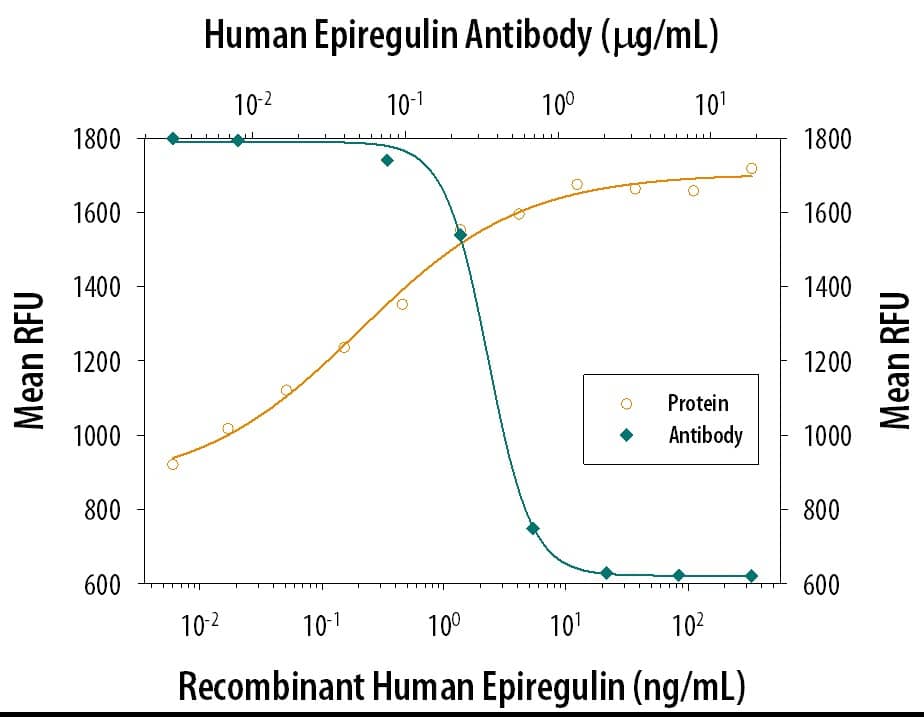Human Epiregulin Antibody Summary
Val63-Leu108
Accession # O14944
Customers also Viewed
Applications
This antibody functions as an ELISA capture antibody when paired with Goat Anti-Human Epiregulin Antigen Affinity-purified Polyclonal Antibody(Catalog # AF1195).
This product is intended for assay development on various assay platforms requiring antibody pairs. We recommend the Human Epiregulin DuoSet ELISA Kit (Catalog # DY1195-05) for convenient development of a sandwich ELISA.
Please Note: Optimal dilutions should be determined by each laboratory for each application. General Protocols are available in the Technical Information section on our website.
Scientific Data
 View Larger
View Larger
Human Epiregulin ELISA Standard Curve. Recombinant Human Epiregulin protein was serially diluted 2-fold and captured by Rat Anti-Human Epiregulin Monoclonal Antibody (Catalog # MAB14252) coated on a Clear Polystyrene Microplate (Catalog # DY990). Goat Anti-Human Epiregulin Antigen Affinity-purified Polyclonal Antibody(Catalog # AF1195) was biotinylated and incubated with the protein captured on the plate. Detection of the standard curve was achieved by incubating Streptavidin-HRP (Catalog # DY998) followed by Substrate Solution (Catalog # DY999) and stopping the enzymatic reaction with Stop Solution (Catalog # DY994).
Preparation and Storage
- 12 months from date of receipt, -20 to -70 °C as supplied.
- 1 month, 2 to 8 °C under sterile conditions after reconstitution.
- 6 months, -20 to -70 °C under sterile conditions after reconstitution.
Background: Epiregulin
Epiregulin is a member of the EGF family of growth factors which includes, among others, epidermal growth factor (EGF), transforming growth factor (TGF)-alpha, amphiregulin (ARG), HB (heparin-binding)-EGF, betacellulin, and the various heregulins. All EGF family members are synthesized as transmembrane precursors and are converted to soluble forms by proteolytic cleavage. Epiregulin was originally purified from the mouse fibroblast-derived tumor cell line NIH3T3/T7 (1). The human epiregulin cDNA encodes a 169 amino acid (aa) residues transmembrane precursor with a 29 aa signal peptide, a 21 aa transmembrane domain and a 21 aa cytoplasmic domain. The putative soluble mature Epiregulin comprising the EGF-like domain (aa residues 64‑104) is formed by proteolytic removal of the propeptide regions (2). There is 85% aa sequence homology between human and mouse epiregulins. Epiregulin is expressed primarily in the placenta and macrophages (3). High level expression has also been detected in various carcinomas. Epiregulin specifically binds EGFR (ErbB1) and ErbB4 but not ErbB2 and ErbB3. It activates the homodimers of both ErbB1 and ErbB4. In addition, epiregulin can also activate all possible heteromeric combinations of the four ErbB family members (4). Epiregulin stimulates the proliferation of fibroblasts, smooth muscle cells and hepatocytes. It has been shown to be an autocrine growth factor for epidermal keratinocytes as well as mesangial cells (5, 6). Epiregulin has also been shown to inhibit growth of several epithelial tumor cells. In addition, Epiregulin has been implicated in the implantation process during pregnancy (7).
- Toyoda, H. et al. (1995) J. Biol. Chem. 270:7495.
- Toyoda, H. et al. (1997) Biochem. J. 326:69.
- Komurasaki, T. et al. (1997) Oncogene 15:2841.
- Shelly, M. et al. (1998) J. Biol. Chem. 273:10496.
- Shirakata, Y. et al. (2000) J. Biol. Chem. 275:5748.
- Mishre, R. et al. (2002) Am. J. Physiol. Renal. Physiol. 283:F1151.
- Das, S.K. et al. (1997) Dev. Biol. 190:178.
Product Datasheets
FAQs
No product specific FAQs exist for this product, however you may
View all Antibody FAQsIsotype Controls
Reconstitution Buffers
Secondary Antibodies
Reviews for Human Epiregulin Antibody
There are currently no reviews for this product. Be the first to review Human Epiregulin Antibody and earn rewards!
Have you used Human Epiregulin Antibody?
Submit a review and receive an Amazon gift card.
$25/€18/£15/$25CAN/¥75 Yuan/¥2500 Yen for a review with an image
$10/€7/£6/$10 CAD/¥70 Yuan/¥1110 Yen for a review without an image
















